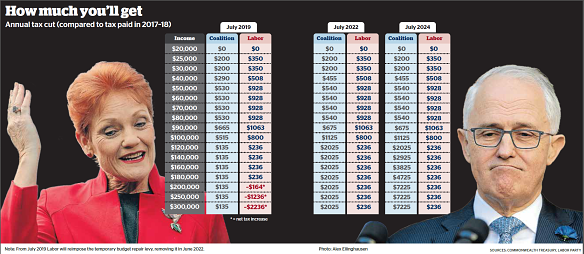- Analysis
- Politics
- Federal
- Income tax
This was published 6 years ago
Who's best on tax, Coalition or Labor? It depends on what you earn and how far out you look
By Peter Martin
Labor’s declaration that it won’t vote for stage two and stage three of the Coalition’s tax plan has suddenly made the choice at the next election clear.
But whether you are better off under Labor or the Coalition after that election depends on how far out you look.
Labor is making no commitments beyond 2019. The Coalition’s tax cuts have two further stages, in 2022 and 2024. Stage two is directed at taxpayers earning more than $90,000 and stage three at taxpayers earning more than $120,000.
Labor won’t vote for either stage two or three, even if it means rejecting everything including the first stage due to start on Sunday week. It argues the latter stages are so far out into the future (two to three elections away) as to make a commitment right now unwise.
The immediate measure both sides agree on introduces a tax offset that peaks at $530 per year for taxpayers earning up to $90,000 and shrinks at higher incomes so that taxpayers on just over $125,000 get nothing.
It also lifts the $87,000 tax bracket to $90,000 so that taxpayers between those two points continue to pay 32.5¢ in the dollar instead of 37¢. At its most, the benefit isn’t big: $270 per year, which is about $10 per fortnight.

How Much You'll get. Coalition and Labor tax packages compared.
Labor will not only support this measure (if it gets the chance and the vote isn't linked to the rest), it’ll go further. From mid 2019 it’ll bulk up the Coalition’s tax rebate by 75 per cent: $530 will become $928 and so on.
The first stage of the Coalition’s tax cuts is indeed directed at middle earners, as Treasurer Scott Morrison promised. Labor will continue to focus on those people and give them more.
But it’ll give nothing more to higher earners, beyond the $10 per fortnight the Coalition is offering from next week. And from July 2019 it’ll treat very high earners more harshly, reimposing the deficit reduction levy the Coalition imposed between 2014 and 2017. It affects only the 5 or so per cent of taxpayers earning more than $180,000 and only that part of their income above $180,000, adding an extra tax of 2¢, pushing their marginal rate up from 47¢ to 49¢, which is 51¢ in the dollar including the Medicare levy.
Bill Shorten said on Tuesday it would only stay in place until the budget was in “strong and sustainable surplus,” which he expected in 2022-23.
Shorten isn’t saying he won’t give further tax relief to high earners, especially when the budget is back in surplus. He is saying that until then, middle to lower earners will have priority.
Peter Martin is economics editor of The Age.